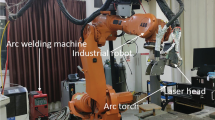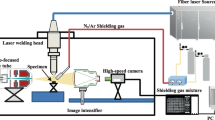Abstract
Porosity is defined as cavity-type discontinuities formed by gas entrapment during solidification. Causes of porosity in fusion welds are the dissolved gases in weld metal and welding process variables that control the solidification rate. To study the mechanisms of porosity formation in weld metal, single-pass gas tungsten-arc weld metal was produced using the bead-on-plate technique on three nickel-copper alloys (80 wt pct Ni-20 wt pct Cu, 65 wt pct Ni-35 wt pct Cu, 35 wt pct Ni-65 wt pct Cu). Four different welding speeds were used under various amounts of nitrogen content in argon-shielding atmosphere. A qualitative model was proposed to characterize the effect of welding variables and solidification substructure on bulk and interdendritic porosity formation. Increasing amounts of nitrogen gas (from 0.2 pct to 6.0 pct in volume) introduced in argon-shielding atmosphere increased the amount of porosity in weld metal. The amount of bulk and total porosity increased as the solubility of nitrogen in the weld metal alloy decreased. The solidification rate of the weld pool is the most important factor controlling the mechanism of porosity formation. The observed amount of bulk pores in this study increased with the increase of welding speed; that is, if the time is insufficient for dissolved and evolved gases to escape during solidification, porosity will result. However, a decrease in the amount of interdendritic pores was observed with increasing welding speed in the 80Ni-20Cu and 35Ni-65Cu alloys. This decrease can be related to the effect of solidification rate on the balance between the disjoining pressure, resistance of the liquid film to be disrupted, repulsion of the bubble from the solidification front, and the hydrodynamic force resisting the movement of the bubble. This balance determines the ability of the cellular solidification front to “equilibrium” capture the pores. Furthermore, the observed decrease of interdendritic porosity with increasing welding speed (80Ni-20Cu and 35Ni-65Cu alloys) can also be related to the time for nucleation and growth of pores in the molten weld metal and their entrapment in the interdendritic channels of a dendritic solidification front. This phenomenon is considered a “nonequilibrium capture” of pores. On the other hand, the 65Ni-35Cu alloy that exhibited a structural transition in solidification substructure with the variation of welding speed showed a slight increase in the amount of interdendritic pores. This increase was correlated to the change of pore-capture mechanism from an equilibrium to a nonequilibrium mode as the solidification substructure changed from cellular to cellular dendritic. To substantiate that the controlling mechanism of interdendritic porosity formation is the nonequilibrium capture, a good correlation between the measured mean pore radius and the interdendritic arm spacing was found.
Similar content being viewed by others
References
J.H. Devletian and W.E. Wood:WRC Bull., 290, Welding Research Council, New York, NY, 1983.
A.T. D’Annessa:Weld. J., 1967, vol.46 (11), pp. 491s-499s.
B. Chalmers:Principles of Solidification, John Wiley, New York, NY, 1964, p. 189.
W.F. Savage, E.F. Nippes, and T.W. Miller:Weld. J., 1976, vol. 55 (6), pp. 165s-173s.
W.F. Savage:Weld. World, 1980, vol. 18 (5/6), p. 2.
J.F. Lancaster:Metallurgy of Welding, 4th ed., Allen and Unwin, London, 1987, p. 212.
P. Hancock:Br. Weld. J., 1964, vol. 11 (11), p. 566.
V.E. Krivosheya:Avtom. Svarka., 1968, vol. 21 (6), p. 17.
G.S. Kuz’min and E.V. Lazarson:Avtom. Svarka., 1968, vol. 31 (9), p. 11.
I.K. Pokhodnya, L.I. Derachenko, V.F. Shelopakov, V.N. Demchenko, and V.M. Abdulakh:Avtom. Svarka., 1978, vol. 31 (6), pp. 1–5.
R.E. Trevisan, D.D. Schwemmer, and D.L. Olson:Welding: Theory and Practice, North-Holland, Amsterdam, 1990, pp. 79–115.
C.J. Smithells: Metals Reference Book, 5th ed., Butterworths, London, p. 586.
National Research Council:International Critical Table of Numerical Data, 1928, vol. 3, pp. 270–71.
I.K. Pokhodnya and L.I. Demchenko:Avtom. Svarka., 1978, vol. 31 (3), pp. 27–29.
I.K. Pokhodnya and V.F. Demchenko:Proc. Conf. on Weld Pool Chemistry and Metallurgy, London, April 1980, The Welding Institute, Abington Cambridge, 1980, vol. 1, pp. 107–19.
S.N. Omenyi, A.W. Neumann, W.W. Martin, G.M. Lespinard, and R.P. Smith:J. Appl. Phys., 1981, vol. 52 (2), pp. 796–802.
D.R. Uhlmann, B. Chalmers, and K.A. Jackson:J. Appl. Phys., 1964, vol. 35 (10), pp. 2986–93.
Author information
Authors and Affiliations
Rights and permissions
About this article
Cite this article
Ramirez, J.E., Han, B. & Liu, S. Effect of welding variables and solidification substructure on weld metal porosity. Metall Mater Trans A 25, 2285–2294 (1994). https://doi.org/10.1007/BF02652328
Received:
Issue Date:
DOI: https://doi.org/10.1007/BF02652328




